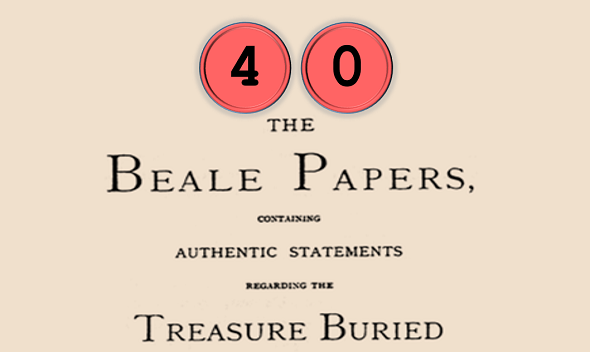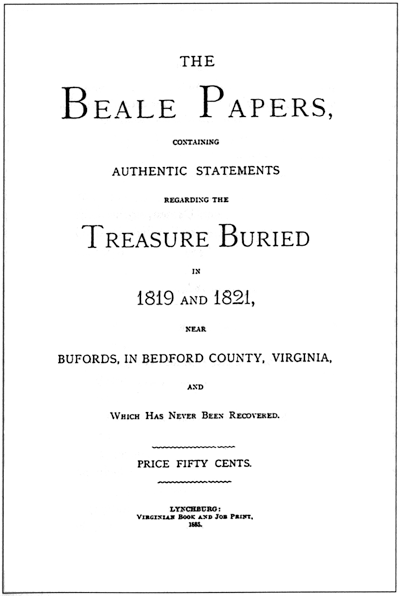The Beale cryptograms are the greatest hoax in crypto history. Generations of treasure hunters have tried to solve them and to find the hidden treasure, the location of which they allegedly describe. Nobody has ever been successfull, as the treasure simply does not exist.
Click here for the complete top 50 list
In 1885 a small publishing company located in Lynchburg, Virginia, published a book named The Beale Papers, which had the appearance of a trashy novel. The plot was a Wild West story about a number of buffalo hunters, who found gold in a canyon in New Mexico. One of the hunters left behind three encrypted notes that contain a description of the place where this gold was hidden.
There is one special thing about this book: the publisher, a James Ward, claimed that its content was true. Allegedly, the group of buffalo hunters actually existed, just like their gold treasure and the place where it was hidden. If one believes this story, the three cryptograms described in The Beale Papers actually lead to tons of gold – provided they can be deciphered. So far, only one of three notes has been broken. The cleartext turned out to be not sufficient for locating the hiding place of the treasure.
The story
The details of the Beale cryptograms have been described so many times before that I don’t want to write down this story again. Instead, I quote Wikipedia:
[The] treasure [was] buried by a man named Thomas J. Beale in a secret location in Bedford County, Virginia, in the 1820s. Beale entrusted a box containing the encrypted messages to a local innkeeper named Robert Morriss and then disappeared, never to be seen again. According to the story, the innkeeper opened the box 23 years later, and then decades after that gave the three encrypted ciphertexts to a friend before he died. The friend then spent the next twenty years of his life trying to decode the messages, and was able to solve only one of them which gave details of the treasure buried and the general location of the treasure. The unnamed friend then published all three ciphertexts in a pamphlet which was advertised for sale in the 1880s. Since the publication of the pamphlet, a number of attempts have been made to decode the two remaining ciphertexts and to locate the treasure, but all efforts have resulted in failure.
The cryptograms
Here is Beale cryptogram #1 (unsolved):
71 194 38 1701 89 76 11 83 1629 48 94 63 132 16 111 95 84 341 975 14 40 64 27 81 139 213 63 90 1120 8 15 3 126 2018 40 74 758 485 604 230 436 664 582 150 251 284 308 231 124 211 486 225 401 370 11 101 305 139 189 17 33 88 208 193 145 1 94 73 416 918 263 28 500 538 356 117 136 219 27 176 130 10 460 25 485 18 436 65 84 200 283 118 320 138 36 416 280 15 71 224 961 44 16 401 39 88 61 304 12 21 24 283 134 92 63 246 486 682 7 219 184 360 780 18 64 463 474 131 160 79 73 440 95 18 64 581 34 69 128 367 460 17 81 12 103 820 62 116 97 103 862 70 60 1317 471 540 208 121 890 346 36 150 59 568 614 13 120 63 219 812 2160 1780 99 35 18 21 136 872 15 28 170 88 4 30 44 112 18 147 436 195 320 37 122 113 6 140 8 120 305 42 58 461 44 106 301 13 408 680 93 86 116 530 82 568 9 102 38 416 89 71 216 728 965 818 2 38 121 195 14 326 148 234 18 55 131 234 361 824 5 81 623 48 961 19 26 33 10 1101 365 92 88 181 275 346 201 206 86 36 219 324 829 840 64 326 19 48 122 85 216 284 919 861 326 985 233 64 68 232 431 960 50 29 81 216 321 603 14 612 81 360 36 51 62 194 78 60 200 314 676 112 4 28 18 61 136 247 819 921 1060 464 895 10 6 66 119 38 41 49 602 423 962 302 294 875 78 14 23 111 109 62 31 501 823 216 280 34 24 150 1000 162 286 19 21 17 340 19 242 31 86 234 140 607 115 33 191 67 104 86 52 88 16 80 121 67 95 122 216 548 96 11 201 77 364 218 65 667 890 236 154 211 10 98 34 119 56 216 119 71 218 1164 1496 1817 51 39 210 36 3 19 540 232 22 141 617 84 290 80 46 207 411 150 29 38 46 172 85 194 39 261 543 897 624 18 212 416 127 931 19 4 63 96 12 101 418 16 140 230 460 538 19 27 88 612 1431 90 716 275 74 83 11 426 89 72 84 1300 1706 814 221 132 40 102 34 868 975 1101 84 16 79 23 16 81 122 324 403 912 227 936 447 55 86 34 43 212 107 96 314 264 1065 323 428 601 203 124 95 216 814 2906 654 820 2 301 112 176 213 71 87 96 202 35 10 2 41 17 84 221 736 820 214 11 60 760




Kommentare (13)